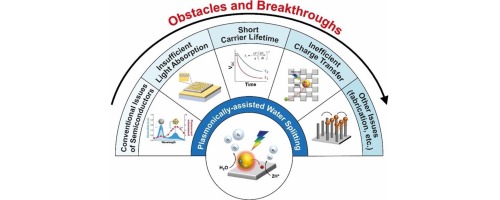当前位置:
X-MOL 学术
›
Nano Today
›
论文详情
Our official English website, www.x-mol.net, welcomes your feedback! (Note: you will need to create a separate account there.)
Plasmonically-assisted nanoarchitectures for solar water splitting: Obstacles and breakthroughs
Nano Today ( IF 17.4 ) Pub Date : 2017-10-01 , DOI: 10.1016/j.nantod.2017.08.008 Joong Bum Lee , Shinyoung Choi , Jeonga Kim , Yoon Sung Nam
Nano Today ( IF 17.4 ) Pub Date : 2017-10-01 , DOI: 10.1016/j.nantod.2017.08.008 Joong Bum Lee , Shinyoung Choi , Jeonga Kim , Yoon Sung Nam

|
Abstract The rising demand for sustainable and efficient solar energy conversion strategies has triggered the development of a myriad of semiconductor-based composite systems for photocatalytic water splitting. Plasmonic nanostructures recently emerged as a promising alternative to conventionally used photosensitizers (e.g., organic dyes) that complement semiconductors as they can uniquely harness the energy of visible photons through the excitation of the localized surface plasmon resonance (LSPR). Provided the solid foundation of the mechanisms with which the plasmonic enhancement effects occur, we herein review the recent progress in the field of plasmonic water splitting by classifying different obstacles and breakthroughs made over the past decade and a half. While plasmonic nanostructures initially served to expand the light harvesting spectrum of semiconductors, rational designs and advanced fabrication techniques have increasingly improved the light absorption capabilities of the plasmonic metal/semiconductor hybrid architectures as a whole. More recently, the use of various analytical tools has allowed a more fundamental issue of short hot carrier lifetime to be tackled which, in turn, has brought about great interest in optimizing the structures and interfaces for more efficient charge transfer. Other issues associated with the field include the complexity of fabrication methods, limited choices in material selection, and cost effectiveness. The review ends with perspectives on future steps to be taken namely the incorporation of co-catalysts, the possibility of using plasmonic heating to assist the catalytic activities, and further investigation of the direct interfacial charge transfer mechanism driven by chemical interface damping (CID).
中文翻译:

用于太阳能水分解的等离子体辅助纳米结构:障碍和突破
摘要 对可持续和高效太阳能转换策略的需求不断增长,引发了无数用于光催化分解水的半导体基复合系统的开发。等离子纳米结构最近成为传统使用的光敏剂(例如有机染料)的有前途的替代品,这些光敏剂补充了半导体,因为它们可以通过激发局部表面等离子体共振 (LSPR) 来独特地利用可见光子的能量。为等离子体增强效应发生的机制奠定了坚实的基础,我们在此通过对过去十五年中取得的不同障碍和突破进行分类,回顾了等离子体水分解领域的最新进展。虽然等离子体纳米结构最初用于扩展半导体的光收集光谱,但合理的设计和先进的制造技术已经越来越多地提高了等离子体金属/半导体混合结构整体的光吸收能力。最近,各种分析工具的使用使得热载流子寿命短的更基本问题得到解决,这反过来又引起了对优化结构和界面以实现更有效电荷转移的极大兴趣。与该领域相关的其他问题包括制造方法的复杂性、材料选择的有限选择以及成本效益。审查结束时对未来要采取的步骤提出了看法,即加入助催化剂,
更新日期:2017-10-01
中文翻译:

用于太阳能水分解的等离子体辅助纳米结构:障碍和突破
摘要 对可持续和高效太阳能转换策略的需求不断增长,引发了无数用于光催化分解水的半导体基复合系统的开发。等离子纳米结构最近成为传统使用的光敏剂(例如有机染料)的有前途的替代品,这些光敏剂补充了半导体,因为它们可以通过激发局部表面等离子体共振 (LSPR) 来独特地利用可见光子的能量。为等离子体增强效应发生的机制奠定了坚实的基础,我们在此通过对过去十五年中取得的不同障碍和突破进行分类,回顾了等离子体水分解领域的最新进展。虽然等离子体纳米结构最初用于扩展半导体的光收集光谱,但合理的设计和先进的制造技术已经越来越多地提高了等离子体金属/半导体混合结构整体的光吸收能力。最近,各种分析工具的使用使得热载流子寿命短的更基本问题得到解决,这反过来又引起了对优化结构和界面以实现更有效电荷转移的极大兴趣。与该领域相关的其他问题包括制造方法的复杂性、材料选择的有限选择以及成本效益。审查结束时对未来要采取的步骤提出了看法,即加入助催化剂,


























 京公网安备 11010802027423号
京公网安备 11010802027423号